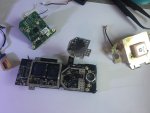- Joined
- Feb 11, 2019
- Messages
- 7
- Reaction score
- 7
Hi all, I have been digging into the battery for the Anafi and wanted to share some of my results. My goal is to build a replacement battery for under $20 that is higher capacity but similar in weight. Also a battery you can hook up to a balance LiPo battery charger such as the B6 charger so you can get increased speed in charging.
First the battery. The Anafi has a 2 cell LiPo rated at 2700mA @ 7.4v. There are several internal circuits within the battery that allow charge from USB, discharge after a period of time, and logic when connected to the drone. These circuits add weight and which can be better suited for a higher capacity battery (if you charge and balance with a 3rd party charger).
Below is the beginning diagram of the connections of the circuity of the Anafi. In an active but unconnected state, the main terminals are active with the left being negative and right being positive. In the center of the battery are 8 additional pins. None have any measurable voltage while in the active & unconnected state (except Cell 1 Voltage). This holds true for when the battery is charging. Cell 1 Voltage is measured to be half of the total voltage of the battery.
On the drone side, all pins and terminals are independent of each other EXCEPT what I call the Drone Detect pin. It matches with the Voltage (Positive) terminal. My belief is when a battery is plugged in the drone, this pin becomes high, and the battery now knows it is connected to the drone.
My next step is to dissemble a battery fully and wire the pins to a logic analyzer to see what signals are being output. Unfortunately, I currently only have one battery and am not ready to dissemble it. My question then is if anyone has a dead, bad, or donate-able battery for me to do the research with? If so please PM me. I will post the results of my finds once I am done.

First the battery. The Anafi has a 2 cell LiPo rated at 2700mA @ 7.4v. There are several internal circuits within the battery that allow charge from USB, discharge after a period of time, and logic when connected to the drone. These circuits add weight and which can be better suited for a higher capacity battery (if you charge and balance with a 3rd party charger).
Below is the beginning diagram of the connections of the circuity of the Anafi. In an active but unconnected state, the main terminals are active with the left being negative and right being positive. In the center of the battery are 8 additional pins. None have any measurable voltage while in the active & unconnected state (except Cell 1 Voltage). This holds true for when the battery is charging. Cell 1 Voltage is measured to be half of the total voltage of the battery.
On the drone side, all pins and terminals are independent of each other EXCEPT what I call the Drone Detect pin. It matches with the Voltage (Positive) terminal. My belief is when a battery is plugged in the drone, this pin becomes high, and the battery now knows it is connected to the drone.
My next step is to dissemble a battery fully and wire the pins to a logic analyzer to see what signals are being output. Unfortunately, I currently only have one battery and am not ready to dissemble it. My question then is if anyone has a dead, bad, or donate-able battery for me to do the research with? If so please PM me. I will post the results of my finds once I am done.






